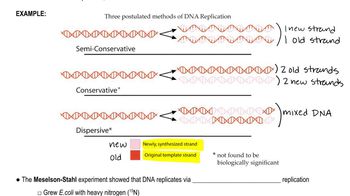Table of contents
- 1. Introduction to Genetics51m
- 2. Mendel's Laws of Inheritance3h 37m
- 3. Extensions to Mendelian Inheritance2h 41m
- 4. Genetic Mapping and Linkage2h 28m
- 5. Genetics of Bacteria and Viruses1h 21m
- 6. Chromosomal Variation1h 48m
- 7. DNA and Chromosome Structure56m
- 8. DNA Replication1h 10m
- 9. Mitosis and Meiosis1h 34m
- 10. Transcription1h 0m
- 11. Translation58m
- 12. Gene Regulation in Prokaryotes1h 19m
- 13. Gene Regulation in Eukaryotes44m
- 14. Genetic Control of Development44m
- 15. Genomes and Genomics1h 50m
- 16. Transposable Elements47m
- 17. Mutation, Repair, and Recombination1h 6m
- 18. Molecular Genetic Tools19m
- 19. Cancer Genetics29m
- 20. Quantitative Genetics1h 26m
- 21. Population Genetics50m
- 22. Evolutionary Genetics29m
17. Mutation, Repair, and Recombination
DNA Repair
Problem 13e
Textbook Question
Answer the following questions concerning the accuracy of DNA polymerase during replication.
If a replication error escapes detection and correction, what kind of abnormality is most likely to exist at the site of replication error?
 Verified step by step guidance
Verified step by step guidance1
<span>Identify the role of DNA polymerase in replication: DNA polymerase is responsible for adding nucleotides to the growing DNA strand and has proofreading abilities to correct errors.</span>
<span>Understand the types of replication errors: Common errors include mismatched base pairs, where an incorrect nucleotide is incorporated into the new DNA strand.</span>
<span>Consider the consequences of an undetected error: If a mismatched base pair is not corrected, it can lead to a point mutation, which is a change in a single nucleotide base pair.</span>
<span>Explore the types of point mutations: These can be silent (no change in protein), missense (change in one amino acid), or nonsense (introduces a stop codon).</span>
<span>Conclude the most likely abnormality: The most likely abnormality at the site of an uncorrected replication error is a point mutation, potentially leading to a missense or nonsense mutation.</span>
Recommended similar problem, with video answer:
 Verified Solution
Verified SolutionThis video solution was recommended by our tutors as helpful for the problem above
Video duration:
2mPlay a video:
Was this helpful?
Key Concepts
Here are the essential concepts you must grasp in order to answer the question correctly.
DNA Polymerase Function
DNA polymerase is an enzyme responsible for synthesizing new DNA strands by adding nucleotides complementary to the template strand during DNA replication. It plays a crucial role in ensuring the accuracy of DNA replication by proofreading newly synthesized DNA and correcting errors. However, if an error escapes this proofreading process, it can lead to mutations in the DNA sequence.
Recommended video:
Guided course

Functional Genomics
Replication Errors
Replication errors occur when DNA polymerase incorporates incorrect nucleotides into the growing DNA strand. These errors can arise from various factors, including chemical damage to DNA, mispairing of bases, or the inherent limitations of the polymerase enzyme. If not corrected, these errors can result in permanent changes to the genetic code, potentially leading to abnormal protein function or disease.
Recommended video:
Guided course

Semiconservative Replication
Types of Mutations
Mutations are changes in the DNA sequence that can arise from replication errors. The most common types include point mutations, which involve a single nucleotide change, and insertions or deletions, which can alter the reading frame of the genetic code. If a replication error is not corrected, it can lead to these mutations, which may have varying effects on the organism, from benign to harmful.
Recommended video:
Guided course

Mutations and Phenotypes

 1:45m
1:45mWatch next
Master DNA Proofreading with a bite sized video explanation from Kylia Goodner
Start learning




